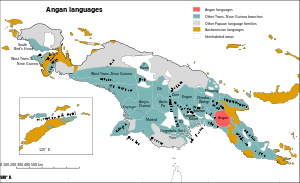Angan languages
| Angan | |
|---|---|
| Kratke Range | |
| Ethnicity | Angu people |
| Geographic distribution | New Guinea |
| Linguistic classification |
Trans–New Guinea
|
| Subdivisions |
|
| Glottolog | anga1289[1] |
 Map: The Angan languages of New Guinea
The Angan languages
Other Trans–New Guinea languages
Other Papuan languages
Austronesian languages
Uninhabited | |
The Angan languages are a family of the Trans–New Guinea languages in the classification of Malcolm Ross. The Angan languages are clearly valid as a family. They were first identified as such by J. Lloyd and A. Healey in 1968; Wurm (1975) classified them as Trans–New Guinea.
- Angan family:
Menya is notable for its dyadic kinship terms (terms referring to the relationship two or more people have to each other), which are present in less than 10 languages and not prevalent in Papua New Guinea (though they also exist in the Oksapmin language).[3]
Pronouns (independent and object prefixes) are:
sg du pl 1 *nə, *ni
*nə-*nʌ, *yʌi
*e(a)-*nʌi
*na-2 *gə, *ti
*gə-*kʌi *sʌi
*se-3 *gʌ
*u-/*w-?
(=3sg)*ku
(=3sg)
References
- Ross, Malcolm (2005). "Pronouns as a preliminary diagnostic for grouping Papuan languages". In Andrew Pawley; Robert Attenborough; Robin Hide; Jack Golson. Papuan pasts: cultural, linguistic and biological histories of Papuan-speaking peoples. Canberra: Pacific Linguistics. pp. 15&ndash, 66. ISBN 0858835622. OCLC 67292782.
- ↑ Hammarström, Harald; Forkel, Robert; Haspelmath, Martin, eds. (2017). "Angan". Glottolog 3.0. Jena, Germany: Max Planck Institute for the Science of Human History.
- ↑ Ankave is not listed in Ross's classification. It has the 1sg pronouns based on ni, but not a 2sg based on ti.
- ↑ The Oksapmin Kinship System Archived 2009-09-20 at the Wayback Machine., retrieved May 21, 2009.
This article is issued from
Wikipedia.
The text is licensed under Creative Commons - Attribution - Sharealike.
Additional terms may apply for the media files.